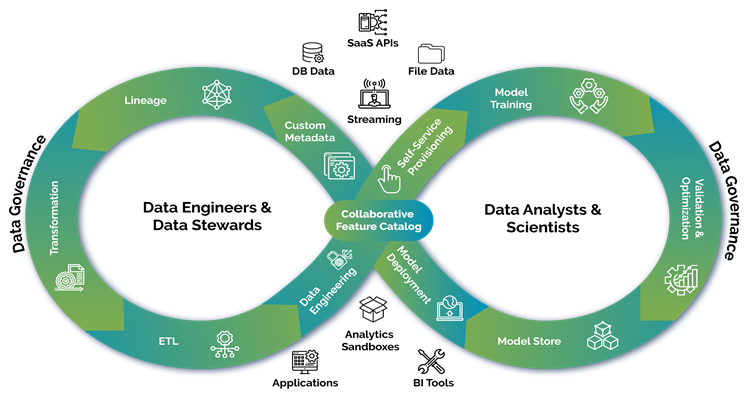DataOps and MLOps: Two crucial waves of operationalization (XOps)
With the increase in digitization, technological advancements, and data-driven culture, organizations are adopting agile software development practices. This paved a way for ‘XOps’ that improves business operations, efficiencies, and customer experiences by enabling teams to collaborate and communicate better while stimulating automation techniques to build an effective Ops process. It ensures reliability, reusability, and repeatability while reducing duplication of technology.
XOps began with DevOps that is an amalgamation of development and operations. According to Statista, DevOps practices across organizations grew 17% in 2018 against 10% in 2017. Like DevOps, various types of Ops such as DataOps (data), MLOps (AI models), ModelOps, Platform Ops for AI, and AIOps (analytics insights) are cross-functional endeavors focused on continually improving efficiency, and processes. Organizations are now leveraging DevOps for operationalizing their data analytics and AI architectures.
Why is there a need to operationalize AI?
As organizations embark on their digital transformation journey, CIOs are faced with daunting challenges such as:
- Reducing the time to market the product.
- Mitigating risks and improving productivity.
- Increasing the top line by introducing new business models.
- Improving the bottom line by improving the total cost of ownership.
AI and data-driven analytics are at the heart of this transformation. The success of this transformation is tied to underlying infrastructure technologies, which need to be real-time, agile, scalable, and resilient. However, most of the time, analytics and AI projects fail because operationalization is only addressed as an afterthought. Few barriers to scale and operationalize data analytics and AI are as follows:
- Integrating the solution within existing enterprise applications and infrastructure is hard.
- Overlapping capabilities of data analytics and AI pipelines makes it difficult to identify the right product and framework for implementation.
- Integration and maintenance challenges while moving analytics and ML artifacts from deployment to production.
This is due to the lack of operationalization for the distinct and individual subcomponents of the pipeline- data, ML, and models. Hence there is a need for DataOps, and MLOps. It implements a framework for the collaboration of data engineers, citizen data scientists, and ML engineers to deliver and manage AI-based systems while defining an operating model that is secure, compliant, and cost-effective.
HyperSense DataOps
In today’s enterprise world, data is the fuel for driving profitable decisions and successful innovations which provides a sustainable competitive advantage. It is a key component for driving analytics, exploring market opportunities, and understanding business insights. Unlocking the value from data in new ways can accelerate an organization’s journey to AI. Yet, when data-related projects fail to deliver the promised Return on Investment (ROI), stakeholders want to know why. According to Experian’s 2019 Global Data Management Research report, 89% of businesses report that they struggle with managing data. These struggles include delays in insight and a lack of trust in underlying data.
For organizations seeking a transformation within their data operations, AI-enabled automation technology can deliver a competitive advantage. It becomes valuable when trusted business-ready data helps drive differentiated insights and operational excellence for the business. Something that can be achieved by using platforms such as the HyperSense DataOps.
DataOps is the coordination of people, processes, and technology to deliver enriched and trusted business-ready data to citizen data scientists to execute AI experiments quickly. It focuses on improving the use and value of data in a dynamic environment.
How HyperSense DataOps helps?
- It enables augmented data transformation that drives speed and scale for various analytics use cases throughout the lifecycle of a project or an engagement.
- It assists use-case-specific analytics by combining pioneering technologies with augmented analytics, data governance, and advanced feature engineering capabilities to operationalize high-quality insights across various business lines of an organization. It increases efficiency, quality, and governance of data operations.
- It provides a degree of self-service to the data engineering team, which is unparalleled in the enterprise space giving the right people the right data at the right time of need.
- It makes it easy to consume data for organizations struggling with trivial issues like defining data engineering roles, creating enterprise rules and data pipelines. These augmented with the right people and process will ensure that the AI experiments are executed quickly on trusted and clean data.
- It helps track data lineage by providing services like data curation, metadata management, data governance, and master data management.
Organizations that have successfully deployed any DataOps programs know that they need a technology platform that gives them access to the data they can trust, understand its meaning, provide quality, and use their value to its maximum potential.
Hypersense DataOps helps businesses derive value from their data. It ensures operational excellence and collaboration. AI-readiness in HyperSense helps differentiated experiments, and most importantly, gives you a competitive advantage to get ahead and move forward.
HyperSense MLOps
Machine Learning operationalization (MLOps) is a practice that aims to make developing and maintaining production machine learning seamless and efficient. It streamlines the deployment, operationalization, and execution of ML models alongside the ML pipeline. It is where experimental data science meets an enterprise production environment where business value is created.
Establishing MLOps introduces AI models into apps a more-tuned, scalable, and successful process. AI models are traditionally deployed in a one-off fashion, and data scientists and data engineers often lack the skills to operationalize models into production environments. Application integration, model monitoring, and tuning, and workflow automation are afterthoughts. Therefore, it makes sense to bring model and app development together on a data and AI platform to harness assets and intelligence.
How HyperSense MLOps helps?
- It is ideal for implementing and integrating ModelOps and DevOps in an enterprise environment that is either on-Prem, on Cloud, or Hybrid in nature.
- It enables models to be pushed from a data science team to the DevOps team in a regular deployment and update cycle, aligned with continuous integration and deployment (CI/CD) to suit business needs. Powered by a powerful AI Studio, HyperSense integrates with the code platform to build and scale AI to promote explainable AI.
- It automates the time-consuming portions of data science and AI; citizen data scientists can see the results of their experiments at scale faster than before.
- It facilitates collaboration between the citizen data scientist team, DevOps, and app developers, which reduces the complexity of deploying and optimizing models in production.
HyperSense platform enables you to get a clean start with data science and helps you manage end-to-end AI experiment and production deployment lifecycle – no coding or lengthy training required. Any AI model built can be saved and deployed using HyperSense AI Studio. This feature helps you select, save, and deploy the model within the same cohesive platform.
HyperSense enables data scientists & citizen data scientists to understand which factors contributed to a specific outcome and what correlations occurred. It allows the team to align on the results by looking at different algorithm outcomes and studying the algorithms used, and judge effectiveness within algorithms. It lets data scientists do what they do best—use human intelligence to deliver AI solutions to business problems. Data scientists can take code produced by HyperSense and modify it further to suit enterprise and business use case-specific needs and deploy it in production at hyper-scale.
HyperSense platform is a no-code Augmented Analytics platform that uses Machine Learning and AI to assist in data preparation, insight generation, and insight explanation to augment how enterprises explore and analyze data. This platform leverages DataOps and MLOps practices to enable automation for deploying, monitoring and governing the data pipelines, ML pipelines, and ML models through the CI/CD framework and delivery of AI/ML models into production. It improves reliability, reusability, collaboration within different teams, and business results.
Is your organization ready to adopt DataOps and MLOps practices? If yes, let me your thoughts in the comments section below.
Learn how augmented analytics can help transform your approach to enterprise AI




